
For the descendents of Richard Dearie and his son John Russell
Margaret Dearie nee Watt
28 October 1804 - 29 August 1837
Compiled from research by Geoffry Swinfield and Mary White.
Margaret Watt was born in Stevenston, a small village, 29 miles South West of Glasgow, in 1804.
Her father Alexander was a weaver and the family except for the oldest child John; can be found living in Mill Hill on the 1819 census. They are still there in 1822.
A description of Stevenston in Pigot’s directory of 1837 says it consists of one street half a mile in length. There is coal locally and “A great portion of the inhabitants of the village are employed in weaving, and through the agents here the works of their looms are conveyed to the Glasgow houses. The present church is a neat and handsome building, of modern erection.”
One mile South West was Saltcoats; once a busy seaport, the Napoleonic war had contributed to the decline of the whole area.
In 1824 Margaret married Richard Dearie Their fathers were both weavers. They had 6 children, the youngest born in February 1836.
John Watt, Margaret’s older brother had emigrated to America and sent for his family in 1836.
The ship’s passenger list for the “Agnes and Anne “ shows Hugh Watt, with Mrs. Watt, (his mother?) his sisters Marion and Elizabeth, and Margaret, with Margaret’s five sons. They arrived in New Orleans on the 12th August 1836.
Margaret had, according to her husband Richard, deserted him.
Richard and Margaret’s daughter Maria is not on the passenger list and since Richard later names another of his daughters Maria; she may have died young in Scotland.
The” Agnes and Ann” had sailed via Kingston Jamaica
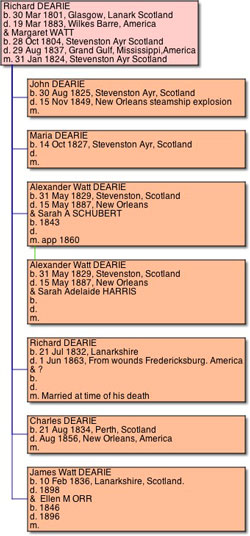
Margaret survived for only a year after her arrival in America.
She died on August 29th 1837, aged 33, from yellow fever, part of a massive outbreak that killed thousands, including her brothers Hugh and Robert.
She was buried with them at Grand Gulf Military Park Cemetery Mississippi, which is about half way between Natchez and Vicksburg.
Her mother Maria was left in Natchez to bring up her five boys: John, aged 12, Alexander 8, Richard 5, Charles 3 and James aged one.
During their youth in the 1840s their father Richard was in New York with his second wife Elizabeth having a second family.
It seems likely that Margaret Watt’s brother John of the firm Watt and DeSaulles must have supported his sister’s children. His own children were born in Natchez, Mississippi, which at the time was a prosperous cotton growing and transhipment centre.
Their education seems to have been satisfactory since John, James and Richard all become clerks and Alexander a jeweller.
John, the eldest son, became a clerk with Morton and Co., a Wall Street banking firm.
On 15 November 1849 tragedy strikes when he is killed along with 200 others in the explosion of the steamship Louisiana.
Transcription of article above right. The New Orleans Day Bee Friday - Morning Nov 16 1849 Awful Steamship Explosion
Frightful Loss of Life Two Hundred Persons Killed
We are sincerely distressed at being compelled to record one of the most appalling catastrophes that ever occurred in our city. The Steamboat Louisiana, Capt. Cannon, bound to St Louis was to have left yesterday afternoon at five 'o clock. Either at the moment of starting and after one or two revolutions of her wheels, or just before backing out of the wharf- for accounts differ on this point-both her boilers exploded, with a detonation equal to a park of artillery. A scene of destruction followed which beggars description. The boat it seems was crowded with cabin and steerage passengers- many of the spectators of the terrible event averring that there must have been from 100 to 150 persons on board. The explosion completely shattered the Louisiana, almost literally breaking her into fragments, which were hurled into the air with frightful momentum and velocity, obscuring the atmosphere and falling at distant spots all along the Levee and into the river. As an illustration of the tremendous projectile force of the liberated steam, we will state that the main boiler had broken from its connections and driven through the air with irresistible force more than 150 yards. On its passage two men and a mule were struck by it and killed. In descending it came into collision with some cotton bales, which fortunately diminished the violence of its course, and it finally fell with a prodigious ?? on the pavement at the corner of Canal Street and the Levee, only a few feet from the door of a coffee house. But for the cotton bales the hurtling mass would have inevitably been projected into the coffee house and occasioned a serious destruction of both life and property.
It may be readily conceived that the Louisiana was utterly broken in pieces by the explosion. An hour after the accident nothing remained of her save floating vestiges or the debris of her hull, which were scattered about the Levee or floated on the surface
of the river So much of the boat as remained entire sank almost immediately.
With respect to the most afflicting phase of this awful calamity the details are meagre. The loss of life on board the boat was such that we could not find one man who had escaped with life and unscathed limbs to aid us in calculating the numbers, or chronicling the names of those who perished. The terrific suddenness of the catastrophe and its awful rapid consummation, must have involved more than the average amount of mortality and suffering.-
Many bodies were hurled upon the shore, and quivering members, which had been torn from their sockets, were picked up in our presence; but undoubtedly a large number of the crew and passengers must have been thrown into the Mississippi by the shock and drowned. Of those on board the Louisiana the traces are indeed few and faint. But the injury and destruction were not confined alone to that ill fated steamer. The Storm, which had just come in, and was in the immediate proximity to the Louisiana, though not shattered to fragments was terribly damaged, her hurricane deck smashed, her cabins destroyed and her pilothouse broken up. Many of the passengers and crew of the Storm were dreadfully wounded by fragments of the Louisiana, or scalded by steam and some doubtless were killed. We ourselves beheld more than one dead body carried away from the boat. The Bostona, another steamer lying in the vicinity of the Louisiana suffered considerable damage, and the John Hancock had her chimneys knocked away and received other injury.
This we believe is one of those frightful disasters in which public rumour underrates rather than exaggerates the loss of life. From the nature of the catastrophe and from its sweeping and desolate effects, it is necessarily difficult, particularly in the confusion and bewilderment that succeeded, to obtain accurate details, but we are morally convinced that the victims will be found to be more numerous than those to any similar calamity which has happened in our waters for many years. Such further details in elucidation of the horrors of the casualty, as we now may be able to gather during the night, will be added in a postscript.
We have just heard that the numbers of those on board the Louisiana at the time of the explosion is estimated at from two to three hundred. There was besides a very large crowd assembled on The Storm, The Bostona and other boats lying adjacent to her If there be any truth in those reports, the victims must be counted by hundreds.
POSTSCRIPT...
(34 lines on what happened before explosion here)...
On repairing to the Levee at 7 o'clock in the evening, the scene was most distressing. As fast as the dead bodies were recovered, they were moved to spots selected for the occasion. and carts were forthwith engaged to carry them to the Baronne Street watch house. Women in the almost mortal stages of agony were looking for their husbands and brothers, whilst strong men with tears in their eyes, might be seen wending their way through the crowd in search of some lost relative. Mutilated corpses, horribly disfigured met the eye at every step, whilst ever and anon the most piercing shrieks indicated the approach of some wounded individual praying for death to relieve him from his dreadful sufferings. May we never again encounter a calamity so terribly heart rending!
....(Description of rescues and hospital. List of those in hospital. List of known dead....
List of missing including Mr. Dearie, nephew of Mr. Watt, firm of Watt & DeSaulles and Clerk with Morton and Co.
His Uncle John Watt registers his death.

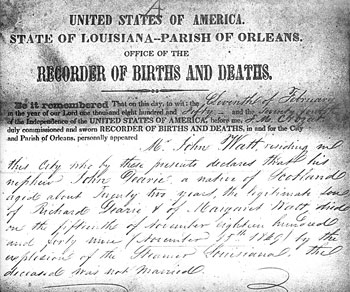
By 1851 the boys' father Richard was back in London. A year later when Richard’s second wife Elizabeth gave birth to a son in December 1850 Richard named him John.
But he died a year later in September 1851; his death registered by Alexander Dearie, now aged 22 who was visiting his father.
Alexander returned from the visit in 5 February 1852, arriving back in New Orleans from Glasgow on the ship Mary Morris. He gave his profession as jeweller.
Four years later Charles another of Richard’s sons died in New Orleans in 1856 aged 22.
The funeral took place at the home of his Aunt Mrs Brown, who lived in Apollo Street.
This is likely to be E. W. Brown listed in the city directory in 1849.
The two sons are buried with their mother and uncles Robert Watt and Hugh Watt at Grand Gulf. Photographs by Dennis Dearie
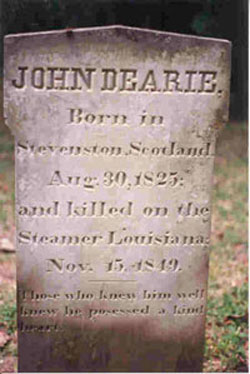
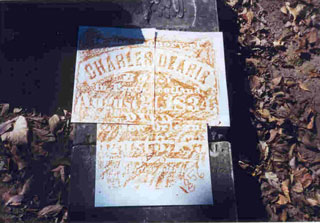
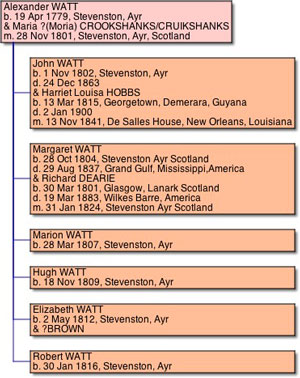

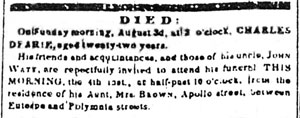

By the 1860 census John Watt and his family are to be found living on Carondelet near Julia. He was a cotton factor living with his wife Harriet who was born in Georgetown, Demerara, Guyana.
He was the brother of Margaret Watt and of Mrs. Brown. Maria Watt, aged 79, his mother was living with him.
The 3 surviving Dearie brothers ran a locksmiths company in New Orleans in Magazine Street:


The War between the States breaks out in April 1861
In May George Dearie a child of Richard Dearie and his second wife Elizabeth Hogg, living in New Orleans, joined the Confederate army. It seems a bit odd that he should be the first of his family to volunteer, although the bounty of $50, which was offered as an inducement, might have something to do with it.
James was the next to enlist, followed by his brother Richard in June. Alexander is the most reluctant leaving it until March 1862 and being discharged after desertion 4 months later. In May 1862 George was captured and in September of that year Richard was promoted. A year later in 1863 Richard was wounded at the battle of Fredericksburg and died of his wounds 2 months later. George was AWOL but he and James were captured in July. By December George had deserted to the enemy. In 1865 in the last days of the war, James was captured again just after Lee has surrendered.
(A summary of their war records follows)
Alexander Dearie enlisted on 5 Mar 1862 at New Orleans as a Private in Company C, Crescent Regiment for the Louisiana Regiment. He was reported on the roll for May and June 1862 as absent under arrest. Discharged July 24 1862.
Richard Dearie enlisted on 7th June 1861 in the 7th Louisiana Infantry at Camp Moore at the age of 27. His occupation is given as clerk. On Sept. 23 1862, he was promoted from Sergeant to First Lieutenant. He is on the list of casualties in Hays Brigade in the battles near Fredericksburg, Va. 27 April- May 4th 1863. He is in the general hospital No. 4 at Richmond Virginia. He is transferred to Charlottesville on April 20 1863. He died of gun shot wounds received at Fredericksburg on 2nd June 1863.His wife received money on I Aug. 1863. The Confederates won the battle of Fredericksburg, successfully driving back the Union army attempting an attack up a steep and enclosed slope. The Union lost 12.600 men, the Confederates 5,300.
George Dearie enlisted as private in the 5th Louisiana Infantry at Camp Moore on 10 May or 4th June 1861 in New Orleans. His occupation was given as clerk. The records show him present on the muster roll from May 1861 to February 1862. On May 24 1862 he is listed as missing at New Bridge Va. He was captured at Bottoms Bridge, Virginia on 24 May 1862, and sent to Fort Columbus, New York Harbour from Fort Monroe, and exchanged at Aitkins Landing, Virginia in August 1862. His description says he was born in London, is aged 21, 5 feet 5 and a half inches tall, light hair, grey eyes and a fair complexion. From August to October 1862 he is absent, detached with the division ordinance train. He is present again from November 1862 but absent without leave in May and June 1863. In August the roll shows him to be missing since July Ist (the first day of the battle of Gettysburg). He was captured at Berlin, Virginia on Ist July 1863 and paroled at Fort Mc Henry, Maryland on 6th July 1863 and sent to Fort Delaware. The Confederate army records of September to December 1863 list him as having deserted to the enemy. In this he was not alone as by the end of 1863 two fifths of the Southern army were absent.
Gettysburg was the most crucial battle of the war, a last throw of the dice for the South as it invaded the north for the second time, and tried to menace Washington in order to bring the war to an end before its rapidly dwindling resources ran out. It lasted three days from July 1st to 3rd. and involved 150.000 men of whom 43.000 died. It is said to be the greatest battle ever fought in the Western hemisphere. The Southern Army led by Robert E.Lee was never able to go so far North again. Here is a description of the second day: “ The hoarse and indistinguishable orders of the commanding officers, the screaming and bursting of shells, canister and shrapnel as they tore through the struggling masses of humanity. The death screams of wounded animals, the groans of their human companions, wounded and dying and trampling underfoot by hurrying batteries; rider- less horses in the moving lines of battle. A perfect hell on earth never perhaps to be equalled, certainly not surpassed, nor ever to be forgotten in a man’s lifetime. It has never been effaced from my memory, day or night for 50 years”
George, who may have been born in the North, may have felt a conflict of interests by this time. Some of his relatives still lived in the North.
James Dearie enlisted on 26 May 1861 as a Sergeant in the Washington Artillery(a Southern army unit) at age of 24. He was discharged from this unit in November of the same year by special order of General Beauregard and enrolled as a Captain in the Miles Legion; Louisiana Militia He was captured at Port Hudson, Louisiana in July 12 1863 and was sent (to New York)? near Baton Rouge in August 1864 for exchange from New Orleans. He was captured again on the 4 May 1865 at Gallatin Road.
See following letter:
3-6th May 1865 Expedition from Rodney to Port Gibson with skirmishes
“On the morning of the 4th, I sent a force of 125 men out on the Gallatin Road, where they met and drove Owen scouts several miles without taking any prisoners. They advanced onto the Gallatin Road eleven miles and on their return captured a Capt. Dearie commissary of substance on General Writ Adam’s staff on leave of absence.’
Letter written by Col. George W. Jackson to Capt A.C. Fiske North Indiana Cavalry from “War of the Rebellion”, Official Records of Union and Confederates (1910) Fiske North Indiana Cavalry Ainsworth and Kirkley Series 1 Vol. 49
(J W Dearie in index.)
We know that James was born in Glasgow but his records say he was born at Natchez Mississippi, and also that he was born in Louisiana. His residence at the time of enlistment is New Orleans but he says his family live at Omberon (Delombre?)
By 1865, following the failure if its invasion of the north, and the Union army finally finding a competent commander in Ulysses Grant, the Confederate army had be driven back to defensive positions around its capital, Richmond, Va.. International support upon which it had pinned its hopes for survival had ebbed way as it became clear there could only be one winner of the struggle. The army was starving and thousands were deserting every day. Robert E Lee surrendered to Grant in April at Appomattox. Jefferson,who had lead the Confederacy, fled to the South. Only scattered fighting went on into May in Louisiana, Alabama and Mississippi. On May 13 the last man was killed. 3 and half million had gone to war, 620.000 had died. A quarter of the men from the South were dead. In Mississippi in 1866 one fifth of the States budget went on artificial limbs.

Alexander, the locksmith, returned to the business in New Orleans. He can be found on the 1880 census with his wife Sarah and 8 children.
His brother James, a bookkeeper, moved to New York where he can be found on the 1880 census with his wife Emma and their 4 children.
George moved to Wilkes Barre where he was a clerk in 1871, then a liquor salesman. He was recorded as proprietor of Dearie's Hotel at 57, Public Square in 1889, with Richard Dearie his father listed as in residence from 1873 to 1882/4.
Richard died in 1883 in Wilkes Barre.
George was back to being a bartender by 1891.
Alexander died in 1887 in aged 58 having lived in New Orleans for 30 years.
The death registers for Luzerne County, show George Dearie aged 60 dying on 17 Jan 1903 at Wilkes Barre of liver complications which would fit with what we know of his bar tending back ground.

The findagrave.com. web site has more photographs of the graves: Here is a link to Margaret Watt Dearie's headstone with the inscription "Erected by John Watt of Natchez to the memory of his affectionate sister, Mrs. Margaret Watt Dearie born in Ayrshire Scotland 29 October 1801, arrived in the United States in December 1836, died at Grand Gulf 29 July 1837."Links to John Dearie and Charles Dearie

Many thanks to Laura Stockett Roberts who contacted this site in September 2011 and provided the photograph of the painting of Margaret Watt and also the research into Watt ancestors seen on the left.
She points out that "John Watt, once established in America, did well for himself. He owned homes in New Orleans and Natchez, one being The Briars, a beautiful home on the bluffs of the Mississippi River."